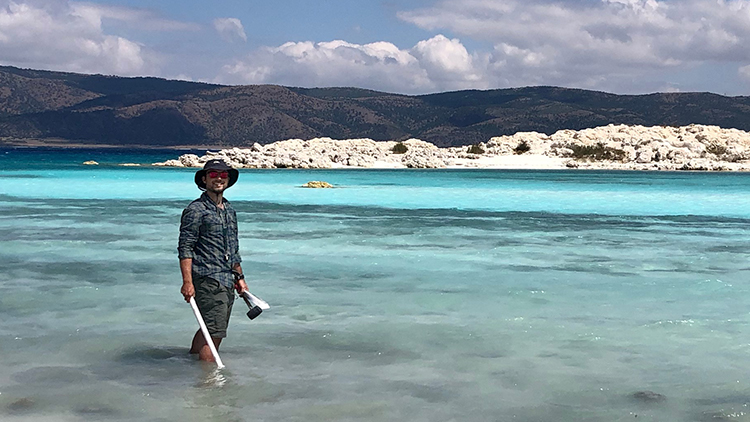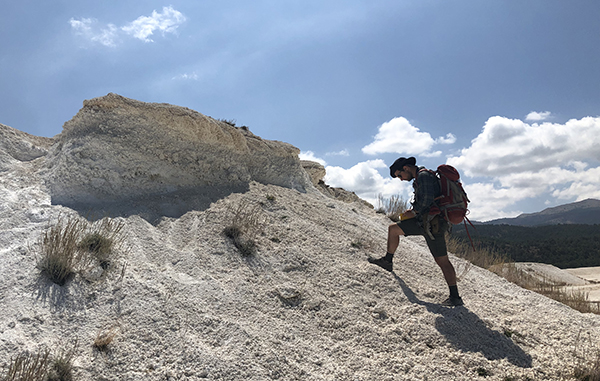EAPS PhD student using earthly examples to explore Mars earns two awards
10-23-2020
Writer(s): Cheryl Pierce

In the far reaches of the Earth, Brad Garczynski searches for answers to the questions of Mars. Garczynski is a PhD Student studying planetary science at the Department of Earth, Atmospheric, and Planetary Sciences at Purdue University. His research takes him to places like Lake Salda in southwestern Turkey which scientists are using as an analog for the Jezero crater on Mars. He is also a student collaborator on the Mastcam-Z instrument and Mars 2020 science team. The Mastcam-Z is the sophisticated mast-mounted system of cameras that serves as the “eyes” of the Rover Perseverance that will land on Mars in February 2021. Because of Garczynski’s work with planetary science at Purdue, he has recently been awarded both the Indiana Space Grant Consortium (INSGC) Fellowship and the NASA Astrobiology Early Career Collaboration Award.
The INSGC is part of the National Space Grant College and Fellowship Program that works to carry out education, research, and public outreach in STEM related to space, aeronautics, aviation, and Earth system science. The Astrobiology Early Career Collaboration Award offers research-related travel support for undergraduate, graduate students, postdoctoral fellows and junior scientists. Both will help Garczynski fund his pursuit of a PhD and answers to the universe.
“Both of these fellowships will greatly help in funding my research and travel costs,” says Garcyski. “The NASA Astrobiology Early Career Collaboration Award will allow me to travel to the NASA Jet Propulsion Laboratory to conduct astrobiological research and collaborate with Dr. Ken Williford, the deputy project scientist of the Mars 2020 mission. The award will also fund collaboration with Dr. Linda Kah at the University of Tennessee, who is a Co-Investigator on the Mars 2020 mission. The Indiana Space Grant Consortium Fellowship will support costs for travel, equipment, and additional laboratory analyses.”
Lake Salda in southwestern Turkey is considered the best place on Earth to mimic what the Jezero crater may have been like on Mars billions of years ago. Scientists around the world study this location to investigate what they might find when the Perseverance lands at Jezero crater.
“Lake Salda is a really unique environment and has similar geological characteristics to Jezero crater,” says Garczynski. “This makes it a great place to learn what the Jezero lake may have looked like billions of years ago and determine the best places we can look for biosignatures, or ancient signs of life, with the rover. I had the opportunity to conduct field work at Lake Salda in August 2019 and I am currently conducting mineralogical and biosignature analyses of the collected samples. The results of this research aim to help refine biosignature search strategies for the Perseverance rover and better understand the geologic history of Jezero crater.”
In addition to the Lake Salda sample research, Garczynski is a student collaborator on the Mastcam-Z instrument and Mars 2020 science team. “I have participated in science team activities including landing site analysis and science activity planning for the mission, and I look forward to being involved with operations of the rover after landing,” he says.
Garczynski graduated from Dartmouth College in 2016 with a BA in earth sciences modified with biology. He grew up on Long Island, NY and went to a small liberal arts school in New Hampshire.
“I had never been to the Midwest nor a large university before visiting Purdue for graduate school,” he says. “It was definitely a change of pace but I have greatly enjoyed my time here.”
When asked why he chose Purdue University, he says that he was excited to work with his advisor, Dr. Briony Horgan, and to be involved with conducting research relevant to the Mars 2020 mission. Because of his earth science background, he was also intrigued by the interdisciplinary nature of EAPS and wanted to be part of the rapidly growing and reputable planetary group.
“It’s very hard to study Mars without having a solid understanding of our own planet, and it’s essential that we look to the Earth to help answer our research questions,” he says. “Being a part of EAPS has allowed me to pursue interdisciplinary collaboration and broaden my expertise and understanding of earth processes that are directly relevant to my research on Mars. I’ve been able to take coursework about lake environments on Earth, participate in department geology field trips, and even have faculty from the geology and geophysics group on my PhD committee, including Dr. Ken Ridgway.”
After graduation, he hopes to pursue a career in science education and mentorship, either as a university professor, outreach coordinator, or high school teacher. He says, “I look forward to pursuing a career in science education and sharing my unique experiences to encourage the next generation of scientists.”
